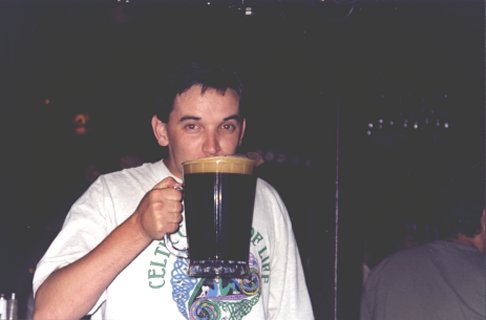 |
| Author Darrin Baird partaking of a "pint" of Guinness at the Knoxville Seisiun at GSBC. |
I have been playing (well actually attempting to play) the bodhran for a couple of years now. You may be wondering "What is a bodhran?". A bodhran (pronounced BOW-rawn), is an Irish frame drum. It has been in existence for at least 1000 years. Typically, a bodhran is 18" in diameter, and the striking surface is made of goatskin. The bodhran is usually played using a double-ended stick called a tipper or beater.
I first encountered the bodhran at a Renaissence festival about 10 years ago. The complex rhythms that were played on such a simple instrument really impressed me. I decided to purchase one and played for maybe a month or so before becoming frustrated and hanging it on the wall. Several years later, I happened upon a group of musicians gathered around playing Celtic music. After asking around, I found that this was a weekly gathering called a "session". I then decided I wanted to get serious about playing.
During my education with the bodhran, I had a question in my mind. " Why hadn't the bodhran been used in Traditional Appalachian Music?" It was sure a simple enough instrument to make and supplies would have been readily available to the Scots-Irish settlers.
I put the question in the back of mind and never really gave any more thought to it. One day as I was playing with a group of musicians, someone asked me the very same question that had puzzled me before. I decide that it was time I found out the reason.
I started searching the Internet for any information about the bodhran. I happened across a bodhran page maintained by Josh Mittleman. It had great sources about the history and legends surrounding the Irish drum.
As I started reading, I found the answer to my question. According to the Ceolas bodhran site, the drum has been in existence as a ceremonial and a war drum for more than a thousand years. It wasn't until the 1960's that the bodhran even made its way as a musical instrument into the traditional Irish music scene. It didn't become popular until the 1970's and today is almost always played in accompaniment with Irish music.
My question turned out to be not as difficult to answer as I thought it might be. The reason the bodhran was not carried into traditional Appalachian music was because it wasn't considered a musical instrument until recently. An answer so simple as that was actually a great relief to me because my search for the truth in bodhran history had ended.
If you are interested in learning more about the bodhran, I urge you to search the Internet. There are some great sites devoted solely to the instrument. I suggest a visit to Josh Mittleman's page located at the above link. I would also welcome any feedback that you may have.
 |
| Author Darrin Baird partaking of a "pint" of Guinness at the Knoxville Seisiun at GSBC. |